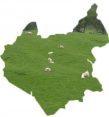Inquisitions post mortem, manorial accounts and court rolls are described in the section in Farming Before 1500, and remain relevant for this period.
Among the most useful sources for this period are probate inventories, especially for the period between 1550 and 1720. Probate inventories list the crops, livestock and household goods that a person owned when they died. Many thousands of inventories proved in the Leicester Archdeacon’s court (which covered the whole county) have been digitised and can be viewed and downloaded through the FindMyPast website (a subscription site). Members of Leicestershire Libraries can view this site free of charge, or it can be seen at the Record Office for Leicestershire, Leicester and Rutland. If you find it difficult to read the writing, The National Archives has an online tutorial which can help.
Search the catalogues of archive offices for other documents which may help. Rentals, tithe books, terriers and surveys, for example, can tell you how much land each person farmed. Wills can help you trace the ownership of a farm through successive generations, although landholdings could be settled on the next generation by a separate deed, which may not survive.
In many parts of Leicestershire, this period is dominated by the enclosure of all or part of the open fields. This might be a single event, or a series of events spread over a century or more. This can be a complex topic, and we have a separate guide to enclosure records.
Probate inventories as a source for farming
Here is a brief extract from the probate inventory of Thomas Jackson of Ibstock, taken in October 1682, to show the type of information these documents contain (spelling modernised, values are in £ s. d.):
In the yard, peas, one stack and in the hovel £7 0s 0d
All the hay £11 0s 0d
In the barn, wheat, rye and blendcorn £13 0s 0d
Barley in the barn £11 0s 0d
Two mares with foals £8 10s 0d
Two colts £11 0s 0d
Four cows and two stirks £10 13s 4d
Four sheep £1 4s 6d
Two swine £2 0s 0d
Cocks and hens 2s 0d
Because this was taken in October, the barns contain a substantial quantity of harvested grain. Some of his land may have been planted with the following year’s crop of wheat, but it’s not listed as it’s not yet worth anything. Blendcorn is two types of cereal crop grown together, which was common in this period. Other words you might see are dredge or drage (barley and oats) and maslin (wheat and rye). In addition to the blendcorn, Jackson is growing wheat, rye, barley and peas. The crop of hay suggests he had some meadow land, or he might have been growing grass to cut on one of his open field strips. The peas and hay were grown to feed livestock. In some places beans were grown instead of, or as well as, peas.
This is a mixed farm, with a few horses, cows, sheep, pigs and poultry. A stirk is a young cow (under 2 years). There is a higher proportion of crops than in many Leicestershire farms. There may be two reasons for this: some of the land in the parish had been enclosed, reducing the amount of grazing available, and cereal prices were high in this period, making cereal crops more profitable.
